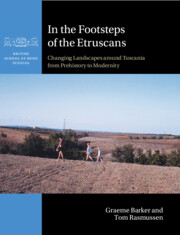Book contents
- In the Footsteps of the Etruscans
- British School at Rome Studies
- In the Footsteps of the Etruscans
- Copyright page
- Dedication
- Contents
- Figures
- Tables
- Contributors
- Preface and Acknowledgements
- 1 The Tuscania Archaeological Survey: Rationale, Aims and Objectives
- 2 Methodologies
- 3 The Natural Landscape and Its Evolution
- 4 Prehistoric Landscapes
- 5 Etruscan Urbanization, c. 700–300 bc
- 6 ‘Romanization’: The Roman Republican Period, c. 300–30 bc
- 7 The Roman Imperial and Late Antique Periods, c. 30 bc–c. ad 700
- 8 Incastellamento and Its Aftermath: Medieval and Modern Landscapes, c. ad 700 to the Present
- 9 A Mediterranean Landscape from Prehistory to Modernity
- Book part
- Bibliography
- Index
9 - A Mediterranean Landscape from Prehistory to Modernity
Published online by Cambridge University Press: 12 October 2023
- In the Footsteps of the Etruscans
- British School at Rome Studies
- In the Footsteps of the Etruscans
- Copyright page
- Dedication
- Contents
- Figures
- Tables
- Contributors
- Preface and Acknowledgements
- 1 The Tuscania Archaeological Survey: Rationale, Aims and Objectives
- 2 Methodologies
- 3 The Natural Landscape and Its Evolution
- 4 Prehistoric Landscapes
- 5 Etruscan Urbanization, c. 700–300 bc
- 6 ‘Romanization’: The Roman Republican Period, c. 300–30 bc
- 7 The Roman Imperial and Late Antique Periods, c. 30 bc–c. ad 700
- 8 Incastellamento and Its Aftermath: Medieval and Modern Landscapes, c. ad 700 to the Present
- 9 A Mediterranean Landscape from Prehistory to Modernity
- Book part
- Bibliography
- Index
Summary
We first summarise the principal findings of the Tuscania Archaeological Survey in terms of the diachronic settlement trends over the past 7500 years that are reconstructed in the previous chapters. The Tuscania story partly mirrors settlement models proposed by other authors for central Italy as a whole and partly diverges from them.In the second section we use a GIS analysis to compare the respective effectiveness of the three landscape sampling strategies we employed. This suggests that all three were equally effective in revealing settlement patterns in the Republican and Early Imperial phases characterized by dispersed and dense rural populations, whereas they revealed contrasting information about the less dense and more variably patterned Etruscan settlement pattern.We review the contribution of the project’s geomorphological studies to the Mediterranean alluviation debate, indicating complex interactions between climate and human actions in landscape formation. The project’s 7500–year ‘archaeological history’ chimes with Peregrine Horden and Nicholas Purcell’s characterization of Mediterranean landscape history as “continuities of form or pattern, within which all is mutability” (The Corrupting Sea, p. 523).
Keywords
- Type
- Chapter
- Information
- In the Footsteps of the EtruscansChanging Landscapes around Tuscania from Prehistory to Modernity, pp. 278 - 295Publisher: Cambridge University PressPrint publication year: 2023



